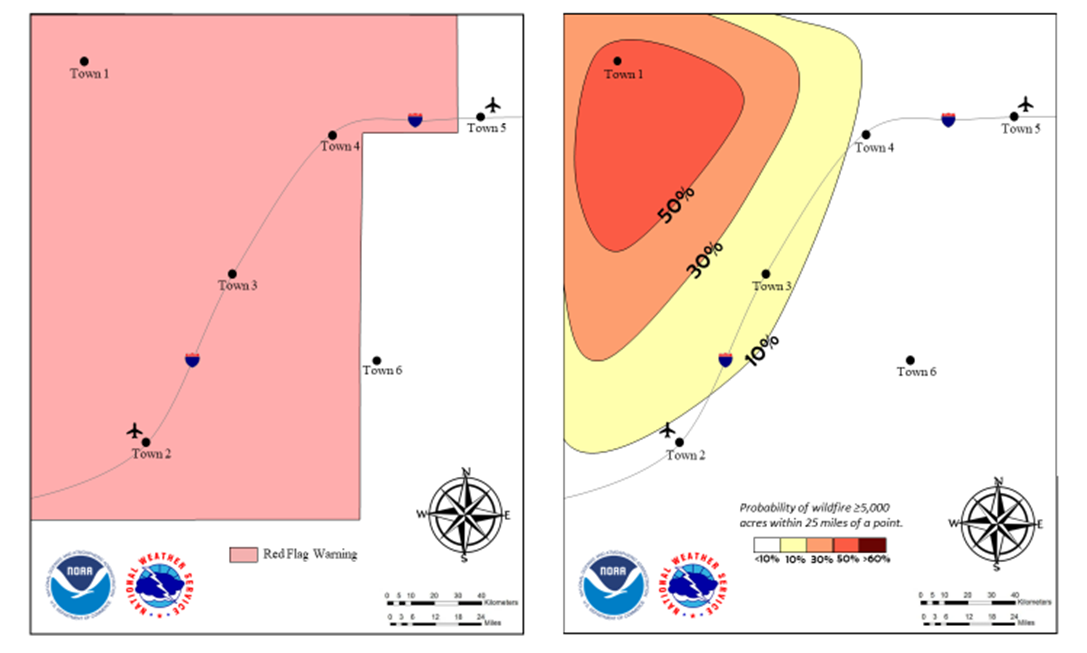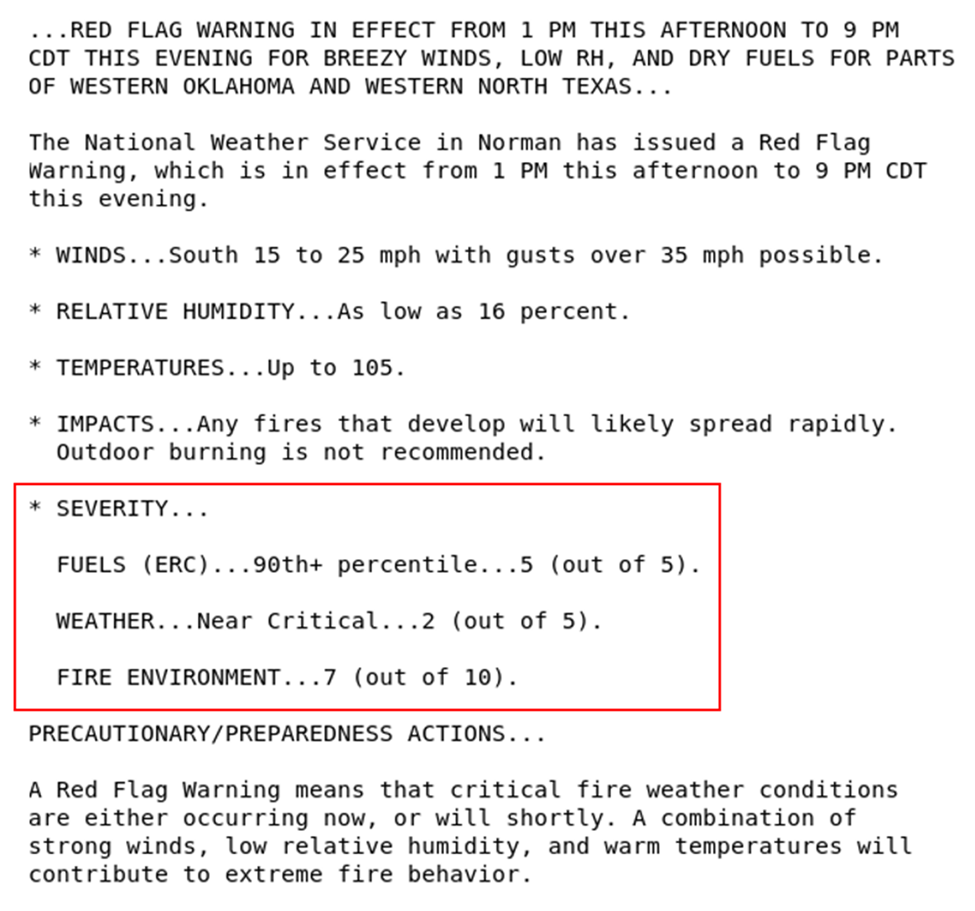Public Information Officer Focus Group Guide
NWS Fire Weather Social and Behavioral Sciences Research
DRSA Fire Weather - PIO Focus Group Guide
Focus Groups
OMB: 0648-0827
National Oceanic and Atmospheric Administration and National Weather Service
Focus Group Guide for Public Information Officers
Public Burden Statement
A Federal agency may not conduct or sponsor, and a person is not required to respond to, nor shall a person be subject to a penalty for failure to comply with an information collection subject to the requirements of the Paperwork Reduction Act of 1995 unless the information collection has a currently valid OMB Control Number. The approved OMB Control Number for this information collection is 0648–XXXX, which expires on XX/XX/20XX. Without this approval, we could not conduct this survey. Public reporting for this information collection is estimated to be approximately 2 hours per response, including the time for reviewing instructions, searching existing data sources, gathering and maintaining the data needed, and completing and reviewing the information collection. All responses to this information collection are voluntary. Send comments regarding this burden estimate or any other aspect of this information collection, including suggestions for reducing this burden to NOAA/NWS Analyze, Forecast, and Support Office: 1325 East-West Hwy, Silver Spring, MD 20910, Attn: Dr. Danielle Nagele, [email protected].
Introduction, Rules, and Participant Introductions
Thank you so much for your time today. Our discussion is part of a study on different roles related to fire weather forecasting and communication, and the use of probabilistic information in fire weather forecasting.
We are conducting this research on behalf of the National Oceanic and Atmospheric Administration and the National Weather Service to find out more about the work of public information officers and their opinions on probabilistic forecasting information.
We are recording the discussion, but nothing you say will ever be associated with your name; we simply use the recording to transcribe comments and analyze the data for research purposes.
Please be candid and honest—the discussion is for research, so there are no right or wrong answers.
To begin, please share your first name; a brief description of your role as a public information officer, where you work, and how long you’ve been in your position.
1) Deterministic vs Probabilistic Information
One purpose of this research is to develop a better understanding of whether probabilistic information integrated into fire weather forecasts can be used by different segments of the population, such as the general public, fire weather managers and/or decision makers, and public information officers.
You’ve likely used a lot of probabilistic information in your work and might be very familiar with concepts like probability of participation (PoP), with percentages presented that illustrate the likelihood of rain or snowfall; Lightning Activity Level (LAL), the 1-6 scale used to indicate how much lightning you are likely to see in a thunderstorm; or probabilities of hurricane winds or surges. For the purposes of this discussion, we would like to focus on your impressions of probabilistic forecasting related to fire weather.
a) What comes to mind when we talk about probabilistic forecasting? Any specific examples of how you have used probabilistic forecasting in your work in the past?
i) In general, do you find probabilistic forecasting information to be helpful in developing your own awareness of a given weather or fire situation? Why or why not?
ii) Do you find this information to be helpful or useful for communicating with the public? How about in terms of helping the public develop their awareness or reaction to a situation?
Next, I am going to share several forecasts and some information with you and then ask some follow-up questions about this information. First, we have two different forecasts that present fire weather alerts in the same part of the country on the same day. Image A contains deterministic forecast information. Image B contains more probabilistic information. Please take a minute to examine the information.
Image A Image B

b) Comparison of Information
i) Based on your first impression, do you find one of these images easier or more difficult to understand? Probe: Specifically, what do you think is easier to understand? Harder to understand? Probe for information about graphics, images, percentages, and other specific content.
ii) Would either of these images be useful in terms of providing information to the public? Which one? Why?
(1) If you needed to communicate the information in Image B with the public right now, would you be comfortable conveying this information? Why or why not? Probe: What specifically might be difficult to communicate to the public?
iii) What information would you use from each image to communicate with the public?
(1) Would you communicate exactly what you see in Image A with the public or would you need to interpret the information before sharing? Probe: What would you need to interpret before sharing? Why do you think that interpretation is necessary?
(2) Would you communicate exactly what you see in Image B with the public or would you need to interpret the information before sharing? Probe: What would you need to interpret before sharing? Why do you think that interpretation is necessary?
iv) Do you think one of these images is more actionable? In other words, do you think you and/or the public would be more likely to change their behavior or take steps toward preparing for a wildfire based on one of these images?
(1) Do you think one of these images conveys more of a sense of urgency or importance?
Finally, we have a Red Flag warning with some probabilistic information added. The information within the red square is added probabilistic information is not information you would usually see in a Red Flag warning. Again, take a minute to look at this information.

c) Use of Red Flag warnings
i) Do you use Red Flag Warnings like this to communicate with the public or develop communication for the public? Probe: What specifically do you use and how do you communicate the information with the public?
ii) Do you have to change the information to fit your specific needs? Probe: Are the changes based on the public or developing your own awareness? What specific need are you addressing with the changes you are making?
(1) Why and how are you manipulating or changing the information? What changes are required for the Red Flag Warning to meet your needs?
d) Probabilistic Addition
i) Does the information in the red box make sense to you?
ii) Do you think this information enhances the usual information provided in a Red Flag warning? Why or why not? How does it enhance the information?
iii) Do you think the information in the red box would help with your decision-making? Probe: would it improve the information you share with the public?
2) Overall Impressions of Probabilistic Information
a) Thinking about all of the images we have shown and the discussion so far, do you think probabilistic information could add value to your understanding of fire weather threats and forecasts? How would it add value/be more useful to you?
i) Do you think probabilistic information could add value to the public’s understanding of fire weather threats and forecasts? How would it add value/be more useful to the public?
b) If probabilistic forecasting information was added to more tools, products, and services, would your process of communication need to change? (For example, if you usually pass a forecast on exactly as it’s given to you, do you think you could continue to do that, or would you need to make changes to your process?)
c) Can you think of any other tools, products, or services that could benefit from this kind of information, or be enhanced by this kind of information? Probe: Which tools, products, or services? How would this additional information benefit or enhance them?
3) Communication and Role in General
a) Next, we would like to talk more specifically about your role and your communication challenges and needs. Let’s start off with a broad question about the challenges you face. In general, what do you see as the biggest challenge in your role as a public information officer?
b) Communication Challenges
i) Now, I would like to talk to you about some specific aspects of communicating with the public and with fire weather decision-makers and partners that provide you with information to share with the public. What are some top-of-mind communication challenges you face when interacting with the public?
ii) What are some top-of-mind communication challenges you face when interacting with partners and fire weather decision makers?
c) Feedback
i) Do you receive feedback from the public about the information you share with them? Probe: What kind of feedback do you receive? Feedback on the quality of the information? The quantity of information? The reliability of information?
(1) Do you ever receive feedback from the public that indicates that something is missing in the messaging? Probe: What do they feel they need that they aren’t getting?
ii) Now, approaching things from the other direction, what do you hear from fire weather managers and/or decision makers? Probe: Are decision makers confirming you have the information you need? Providing guidance about how to share information?
(1) Is there any need to establish better talking points right now? If so, how? Probe: By working with partners? By listening more to public feedback? By providing more direct or specific information?
d) Communication Needs
i) Regarding the public, do you feel that you understand the communication needs of the public and how they change over time?
(1) Please explain some of those needs. Probe: Do they need more translated materials (which languages), simpler materials and information, materials with more detailed information, etc.?
e) Process of Communicating with Public
i) How do you communicate with the public? Probe: Tell me more about the process of sharing information. What methods or platforms do you use? Explain the pipeline of receiving information and sharing information.
ii) Earlier I asked about feedback from the public and what might be missing in messaging, now I would like to know if you think anything is missing. Do you feel that you are able to provide the public with all of the information they need?
(1) Why or why not?
(2) What do you think is missing?
(3) Do you think the public is using the information you provide as intended?
f) Improvements to the Communication Process
i) Are there any aspects of your communication or messaging process that you think should or could be improved? (the transfer of information, the methods you use for sharing and communicating, etc.)
4) Future of Fire Weather and Final Thoughts
Summation of purpose of focus group. Finally, we would like to talk about the future.
a) What kind of changes do you anticipate will occur in the coming years that will impact the work you do?
i) Changes to weather?
ii) Changes in wildfires?
iii) [IF TIME PERMITTED COMMUNICATION DISCUSSION] Changes in communicating with the public? Needs of the public related to communication?
b) Is there anything that you’re not getting now, that you think you will need in the future?
i) Is there any information you are not getting now, but you think you will need in the future?
Does anyone have any final thoughts about the things we have discussed today, specifically related to the probabilistic approach to fire weather forecasting or to anything else we have talked about?
| File Type | application/vnd.openxmlformats-officedocument.wordprocessingml.document |
| File Modified | 0000-00-00 |
| File Created | 2024-07-20 |
© 2025 OMB.report | Privacy Policy